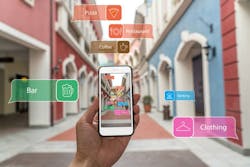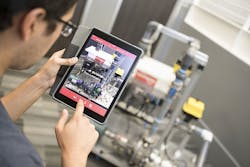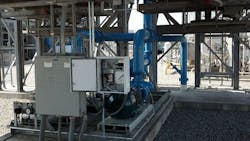With industry analysts predicting 50 billion connected devices worldwide by 2020, the digital landscape continues to rapidly change. From the home to the entertainment space, companies have been harnessing the Internet of Things (IoT) to improve daily life by creating networks of physical devices, home appliances, and vehicles that are smarter and more integrated.
With such an influx of smart, connected devices into our daily lives, the jobs of application developers and technology manufacturers become more difficult. They must learn to use technology to filter through mountains of data in a productive way and get the most relevant data to the person who needs it.
Technology companies are investigating augmented reality (AR) as a potential solution to this big-data challenge. Recent consumer examples prove that augmented reality isn’t just a pipe dream of fanciful technologists. Consider the entertainment space: Pokémon Go took the world by storm more than a year ago. The free smartphone game that combined animated creatures with location tracking and camera technology sent people outside to parks, landmarks, and streets in droves.
Also consider tools such as the Apple ARKit that make apps that overlay data on baseball games or an image of a street. Viewers can see real-time statistics and information about players running on the field or retrieve real-time information about restaurants and shops as they’re walking down the street.
Augmented reality enables data to be overlaid on real-world surroundings, which provides contextualized, relevant data when and where it’s needed.
The Unique Challenges of the Industrial Space
The Industrial Internet of Things (IIoT) involves enormous networks of connected devices, but instead of smartphones and Roombas, the “things” are operational machinery, transportation equipment, and large assets used in production and manufacturing. The data here is huge: ABI Research (Q1 2017) predicts that by 2020, over 78 exabytes of data will be created by industrial machines. At some power plants, over 1.5 terabytes of maintenance data are produced per day.
This data is essential because it can help ensure profitable operation and prevent a costly plant outage. Plants often contain critical assets that need to be properly run and maintained. Big data informs daily decisions that can potentially save—or cost—companies millions of dollars. Not surprisingly, IBM expects the role of “data scientist” to grow 28% by 2020.
Environmental conditions can also pose challenges in industrial environments because the conditions are often harsh and require more rugged systems than offered by the consumer space. Compound that with increasingly more complex manufacturing challenges and aging power-plant assets that require more maintenance, and it’s clear that engineers and scientists must design solutions for acquiring, analyzing, and visualizing all of this data and providing them with useful insight into their systems.
To tackle these challenges, engineers and scientists can harness the benefits of augmented reality to help improve systems in the industrial space. Instead of watching baseball players on a field, engineers can use this technology to view relevant, real-time data overlaid on a manufacturing line to help with assembly or view data overlaid on turbines in a power plant to detect potential maintenance issues.
Smart, Connected Assets and Predictive Maintenance’s Potential
Industrial equipment failures and inefficient maintenance cost businesses tens of billions of dollars every year. The ARC Advisory Group estimates that unscheduled shutdowns, coupled with poor maintenance practices, cost global process industries 5% of total production annually, or $20 billion each year.
Several technology companies, including NI, Hewlett Packard Enterprise, OSIsoft, and PTC, are already exploring how the use of new AR technologies as part of an IIoT solution can decrease downtime, improve efficiency, and promote safety in the industrial space. These technology companies teamed up with Flowserve to collaborate on a real-time, end-to-end predictive-maintenance system featuring AR to help maintenance managers monitor the most critical moving parts in industrial plants such as power plants and O&G refineries.
This smart pump combines technologies that acquire and process data at the edge, software platforms that help analyze and visualize, and cutting-edge AR tools that provide maintenance managers with better insight into their systems.
Data-acquisition devices with onboard processing capabilities gather real-time data from temperature, pressure, flow, and vibration sensors attached to the Flowserve pump. This data is sent to a server, which applies machine learning and analytics algorithms to the data to learn how the pump “should” be operating and to recognize a potential maintenance issue before it causes unplanned downtime.
For the smart pump demonstrator, an iPad running an AR app provides the maintenance team with contextualized data and insights to help them access only the most relevant information while providing proper context: Which pump is in view? How is the control system using the pump right now? Does this particular pump have a history of failure? By managing the Big Analog Data (Big Analog Data is a trademark of National Instruments) challenge with ubiquitous access, processing at the edge, sophisticated analytics, and AR capabilities, the smart-pump solution can increase uptime and reduce maintenance costs across the plant.
AR in a Brewery
Beer lovers might enjoy hearing that beer can also be the product of manufacturing processes that use augmented reality as part of an equipment monitoring solution. To get beer to market as fast as possible while meeting quality demands, breweries must ensure their processes are running smoothly. If not, temperatures that are too hot can introduce “off” flavors to a beer, and temperatures that are too cold can cause the beer to ferment more slowly.
Temperature and pressure must be monitored every hour to carefully control the fermentation process of the yeast. But a California brewery’s old process of taking manual measurements and logging them in a giant binder full of papers was unwieldy and unsustainable. This brewery collaborated with IIoT technology vendors to create an integrated data-acquisition and visualization system to help provide brewery workers with relevant production insights.
Sensors are mounted on the fermenter, and the edge nodes acquire the data from the sensors. The edge nodes then funnel the data to a data historian, which combines the temperature data with specific gravity data to add context for analysis. With analytics, live data feeds and specific trend plots can be created. Brewery production workers can then use an industrial AR device, in this case a head-mounted tablet from RealWear Inc., to view the data and quickly identify any issues that require their attention. Many breweries are smaller or startups, so getting more data from across the process to the fewer workers can help improve production efficiency.
Solutions from IIoT Company Collaborators
Augmented reality goes far beyond Pokémon and other smartphone games. The smart pump and brewery collaborations are just two examples of IIoT companies working together to solve difficult industrial problems. Both collaborations combine interoperable technologies that acquire and process data at the edge, software platforms that help analyze and visualize, and cutting-edge AR tools that get the right data to the right person faster.
Smarter monitoring and predictive-maintenance systems can help keep the lights on at a power plant.
Because our data is getting bigger, our monitoring, manufacturing, and production systems also need to evolve. Augmented reality could someday help companies make better decisions about maintenance, manufacturing, and operations to increase their uptime, plant efficiency, worker safety, and company revenue. Not bad for something that started as a kids’ toy.
Aimee Xia is Product Marketing Engineer at National Instruments.
References:
Industry analysts predict there will be 50 billion connected devices worldwide by 2020. – Cisco
IBM expects the role of “data scientist” to grow 28 percent by 2020.
About the Author
Aimee Xia
Product Marketing Engineer
Aimee Xia is a product marketing manager at National Instruments, specializing in embedded monitoring and IoT applications while also managing a range of software products. She works closely with users of measurement technology to understand the market and develop product positioning and messaging, proof-of-concept applications, and technical content. Aimee has a degree in mechanical engineering from the University of Michigan and is a Certified LabVIEW Architect.




